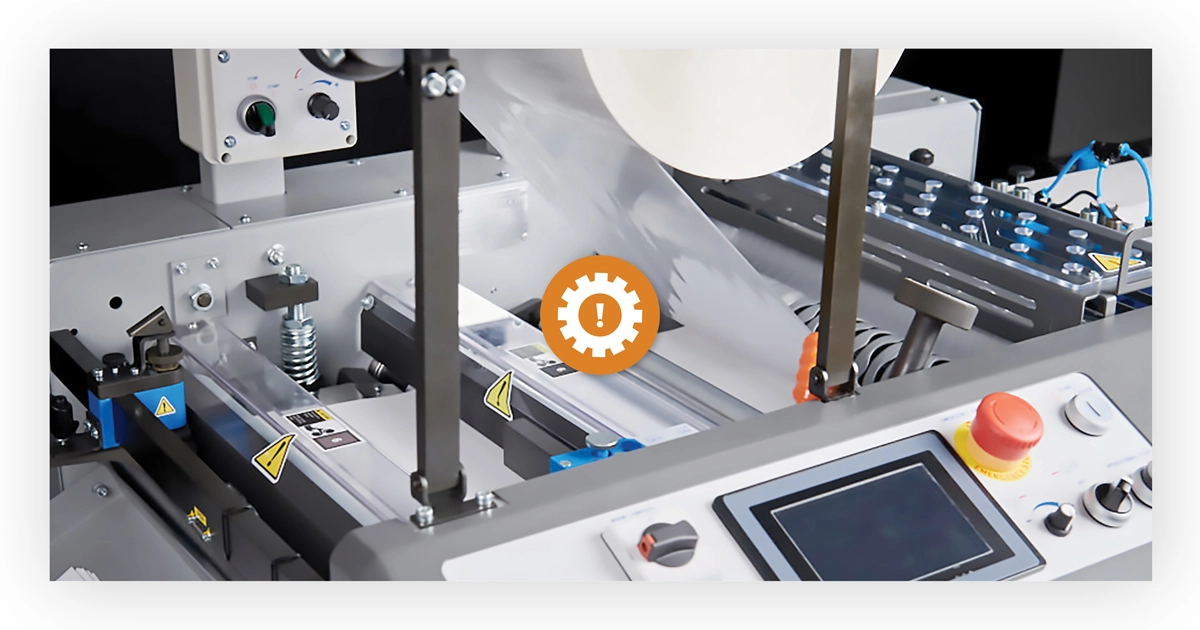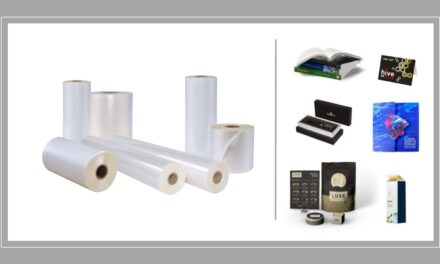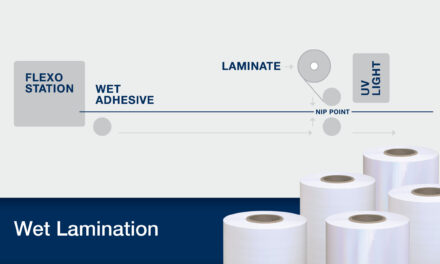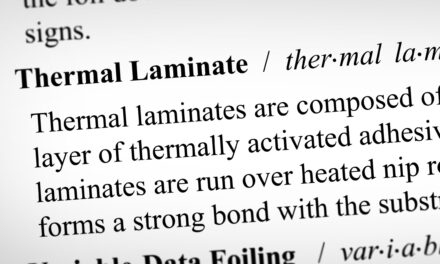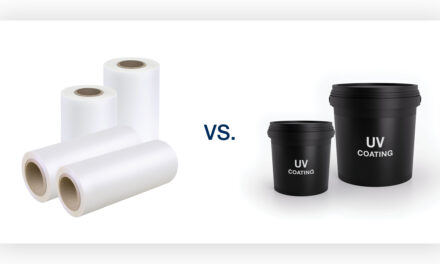PINPOINTING PROBLEMS AND FINDING SOLUTIONS
Thermal lamination can be a deceptively complicated process. In order to produce a flawless laminated print, everything from the laminate and substrate to the laminating equipment must function together in perfect harmony. When something goes wrong, it is up to the operator to investigate the issue or call a technician to figure out the root cause. In this article, we will cover some of the most common quality issues that arise in thermal lamination and explore a few potential solutions for each.
COMMON THERMAL LAMINATING ISSUES AND THEIR SOLUTIONS
The following points are listed in no particular order as some issues are more likely to crop up than others depending on the quality of the laminate, age or condition of the laminator, and a variety of other contributing factors.
While we hope this post will serve as a helpful place to start in diagnosing any poor-quality results, the best way to ensure your lamination jobs are consistently up to par is to validate your vendors, prioritize regular maintenance of your equipment, and perform a trial run on any new materials that enter your facility without exception. Set your operation up for success by proactively taking steps to minimize the risk of errors on live jobs.
Wrinkles
Wrinkling can affect both the look and feel of a laminated print and serves as an immediate signal that something has gone wrong in the lamination process. The most frequent culprit for wrinkling is incorrect orientation of the substrate. For best results, paper should be fed into the laminator with the paper grain running parallel to the rollers.
To identify the grain of a sheet of paper, look at the order of its dimensions. If the second number is longer than the first (i.e. 12″ x 18″), the paper is long grain and should be fed into the laminator in the landscape orientation. If the second number is shorter (i.e. 18″ x 12″), the page is short grain and should be fed in portrait. Substrates run with the grain parallel to the rollers should measure ½ inch wider than the laminate for the best results.
However, if the paper must be run so the grain is perpendicular to the rollers instead of parallel, the substrate should be the same width as the laminate when using polyester (PET), polypropylene (OPP), or nylon films. This practice is especially important for thinner paper. When the paper grain is perpendicular to the rollers, leaving even ¼ inch of paper exposed on either side of the film can cause the rollers to drive the paper into the middle of the unit, resulting in a wrinkle down the center of the web.
Other possible causes of wrinkling include worn or poor-quality nip rollers, curves or bends in the substrate, and a lack of tension on the supply roll, which enables wrinkles to form before the laminate passes the heat roller. The leading edge of the substrate should be flat when inserted into the laminator; sometimes the operator may need to smooth it out as it passes over the feed table and through the rollers. To help paper remain flat, try holding the corners of the trailing edge and pulling back and to the sides simultaneously once the substrate begins feeding in.
Silvering
Silvering looks like tiny bubbles on laminated sheets and occurs when the heat-activated glue on a thermal laminate is not able to press down fully across the surface of the substrate. This effect can be subtle at times, but it will dull the richness of finished prints. It is primarily caused by a lack of heat, pressure, or a combination of the two.
While the average sheet of paper may appear flat to the human eye, many small dips are scattered across the surface. When adhesive is not able to press into these valleys due to a lack of pressure or not being melted fully, small pockets of air will remain trapped in the finished piece. Combining thin films with rough paper can exacerbate this effect as there may not be enough adhesive to fill all the pockets on the paper.
However, older or poorly maintained equipment can also lead to silvering. Older pancake air cylinders are weaker than modern cantilevered pressure cylinders and often cannot apply enough pressure to the sides of the web. Newer machines are stronger, but their rollers still require regular cleaning and replacement to ensure enough pressure is applied consistently over the width of the web. If equipment is the root issue, even thicker laminates with high ratios of adhesive will not produce high-quality results as there is not enough pressure to push air out of the paper’s surface.
To resolve silvering issues, begin by increasing the temperature of the laminator. Be sure to reduce the tension on the unwind roll as heat increases to prevent shrinkage. If raising the temperature of the heated roller does not solve the issue, increase the roller pressure, as well.
Be aware that excessive pressure in the center of the roller can sometimes create bubbles down the middle of the web. In instances like this, the issue is likely not a lack of pressure as much as it is a worn roller. Over time, rollers tend to wear down more quickly in certain areas across their width. If the roller is not applying pressure evenly across the entire web, it likely needs to be replaced by a trained technician.
Haziness
Sometimes a milky line may appear periodically across the width of the web. This hazy effect is typically caused by nip rollers that are not evenly heated. In this instance, the cooler side of the roller prevents the adhesive from melting properly, resulting in a hazy line each time that part of the roller presses down on the substrate. To resolve haziness, be sure to keep the rollers open and moving forward on low speed when the unit is warming up. This enables all sides of the roller to receive the same amount of heat prior to lamination.
Poor Adhesion
Sometimes a job that initially appears to be of good quality will begin to peel or come apart once the laminate has set. This occurs because the adhesive backing on the laminate is not able to maintain a strong bond with the substrate. A variety of factors can result in a weak bond.
Heat/Run Speed
Unless there is an issue in the quality of the laminate (something that should be validated through a trial run prior to live jobs), the likely cause of poor adhesion is an adhesive that is not warm enough. First, try increasing the heat of the roller. Even when a laminate receives acceptable levels of heat and pressure, a high run speed may prevent the adhesive from softening enough to adhere properly to the substrate. A strong bond requires a combination of heat, pressure, and time. Especially for thicker films, slowing the run speed of the laminator may be necessary to give the adhesive layer enough time to absorb heat from the roller.
Ink
One of the most important rules of thumb in thermal lamination is to always let ink dry completely before applying a laminate. Wet ink can cause bubbles and condensation to form between the substrate and the laminate. However, when it comes to adhesion, it is crucial to select the right type of laminate for the ink that is used. Conventional offset and flexographic inks are compatible with most types of adhesives, and some digital inks, such as HP® Indigo inks, are also able to bond with standard laminates. However, many digital alternatives, such as UV inkjet, fuser oils, and toner-based inks, will require superior-strength adhesives, such as our own DigiBOND™ products. Also consider that ink coverage affects bond strength; text-based prints with few graphics will require less adhesive strength than a sheet completely covered with a solid layer of ink.
Paper Stock
Everything from the thickness and texture of paper stock to its acid content can affect its ability to bond with a given thermal laminate. For example, construction paper has a higher acid content than standard copier paper and requires stronger adhesives for quality results. If no other solutions work, the issue may lie in the type of paper stock that is paired with the laminate.
NEED MORE GUIDANCE?
If this troubleshooting guide didn’t help you resolve a quality issue in your lamination process, you can reach out to our team to schedule a service call. Our skilled in-house technicians have cumulative decades of experience maintaining, installing, and repairing thermal laminators all across the U.S. They know our laminates and equipment inside and out and can help you find the root of your quality issues.
We also encourage any operation that uses Nobelus thermal laminating systems to consider purchasing an equipment maintenance agreement (EMA). Our EMA includes several services designed to make thermal laminator ownership a less stressful, more beneficial investment for your team with features such as an annual preventative maintenance visit, free replacements on wear-and-tear parts, and access to virtual support, all at a flat yearly price. To learn more, read What Is an EMA?

